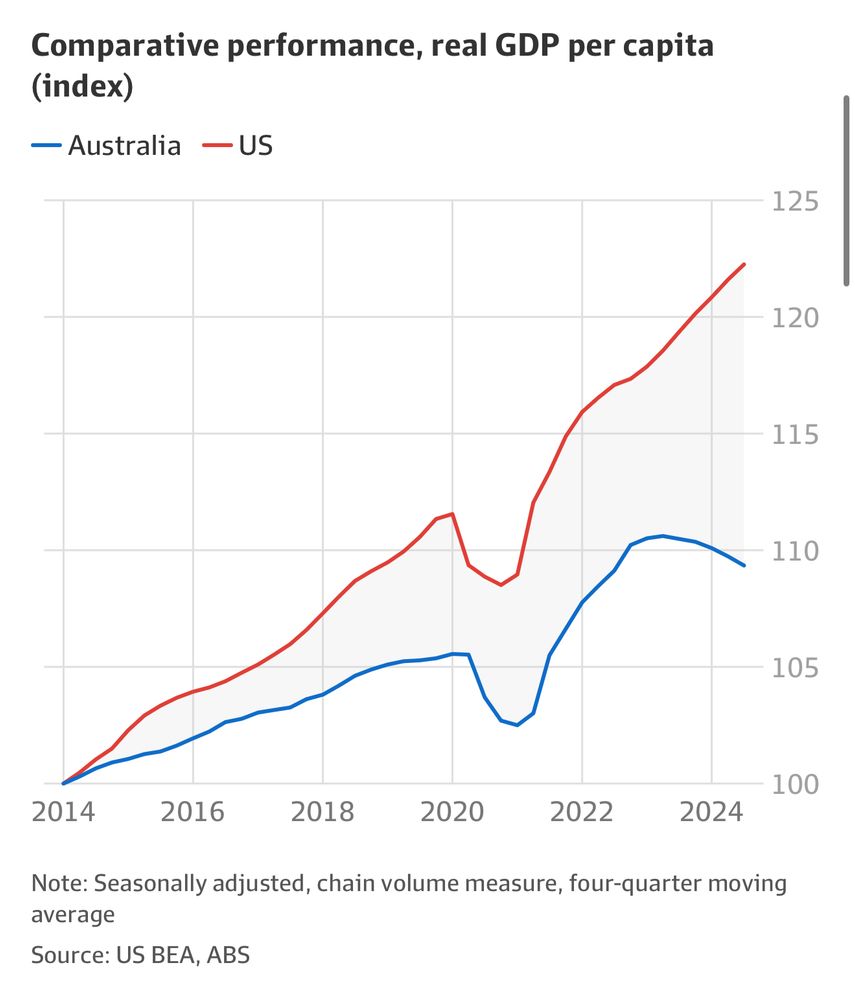
As you can see in my chart in the piece, I am referring to per-capita GDP, a commonly used indicator of living standards. The two countries’ statistical agencies are the source as noted in the chart note.
02.02.2025 17:02 — 👍 0 🔁 0 💬 0 📌 0@shamilton.bsky.social
Junior economist

As you can see in my chart in the piece, I am referring to per-capita GDP, a commonly used indicator of living standards. The two countries’ statistical agencies are the source as noted in the chart note.
02.02.2025 17:02 — 👍 0 🔁 0 💬 0 📌 0😂😍
29.12.2024 19:15 — 👍 0 🔁 0 💬 0 📌 0We need to immediately abolish the eSafety Commissioner.
20.12.2024 02:12 — 👍 6 🔁 1 💬 0 📌 0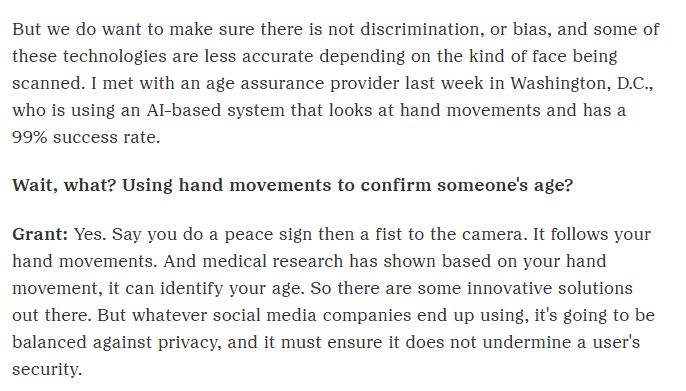
But we do want to make sure there is not discrimination, or bias, and some of these technologies are less accurate depending on the kind of face being scanned. I met with an age assurance provider last week in Washington, D.C., who is using an AI-based system that looks at hand movements and has a 99% success rate. Wait, what? Using hand movements to confirm someone's age? Grant: Yes. Say you do a peace sign then a fist to the camera. It follows your hand movements. And medical research has shown based on your hand movement, it can identify your age. So there are some innovative solutions out there. But whatever social media companies end up using, it's going to be balanced against privacy, and it must ensure it does not undermine a user's security.
I... am going to suggest some vendor sold a load of bullshit to Australia's eSafety Commissioner.
www.npr.org/2024/12/19/n...
The audience for this thread was people who might referee my paper.
17.12.2024 22:43 — 👍 1 🔁 0 💬 0 📌 0Yes, that would be included in the complement of our spending measure. You are not typical!
17.12.2024 22:39 — 👍 1 🔁 0 💬 1 📌 0However, it's nice that the broad swathe of the calibration results is consistent with previous versions of our paper.
Thanks for getting this far! Please read the paper, circulate to those who might be interested, and let us know what you think.
/Fin
We think this more comprehensive modeling exercise does a better job of reflecting the practical features of the program we study (now including retirement and endogenous withdrawal). And incorporating preference heterogeneity allows us to better match the data and recent work.
17.12.2024 17:20 — 👍 0 🔁 0 💬 1 📌 0These results make sense. Withdrawal is easy to reconcile but the size and sharpness of the (mostly non-durable) spending response is not. Liquidity constraints are necessary but not sufficient. Present bias by nature reconciles discordant stocks (liquidity) and flows (spending).
17.12.2024 17:20 — 👍 0 🔁 0 💬 1 📌 0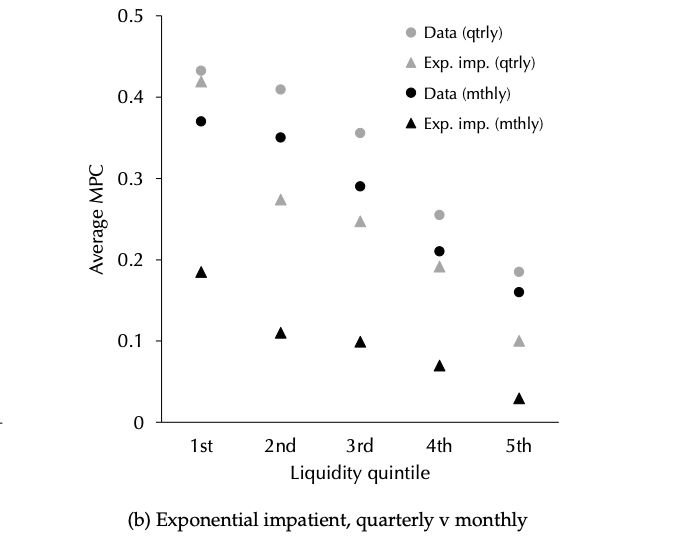
Our fourth main calibration result: the calibration frequency is critical. We use weekly transaction data to observe a sharp spending response (90% within 4 weeks), so we calibrate at a monthly frequency. At a quarterly frequency, the exponential version almost matches the data.
17.12.2024 17:20 — 👍 0 🔁 0 💬 1 📌 0
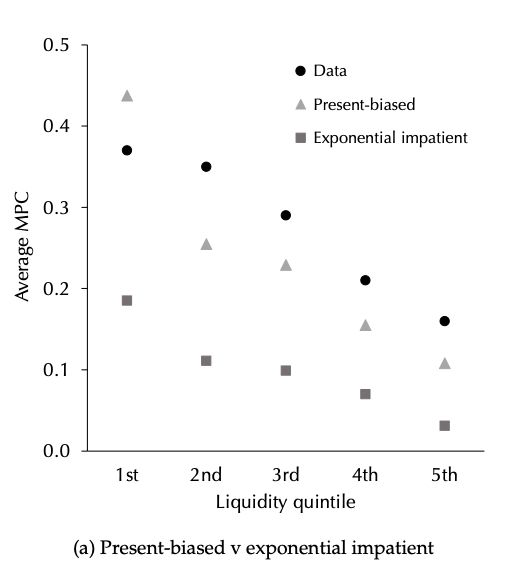
Our third main calibration result: the present-bias version of the model does a much better job of matching the joint distribution of liquidity and spending responses, with parameter values across the whole distribution that are in the ballpark of those in the recent literature.
17.12.2024 17:20 — 👍 0 🔁 0 💬 1 📌 0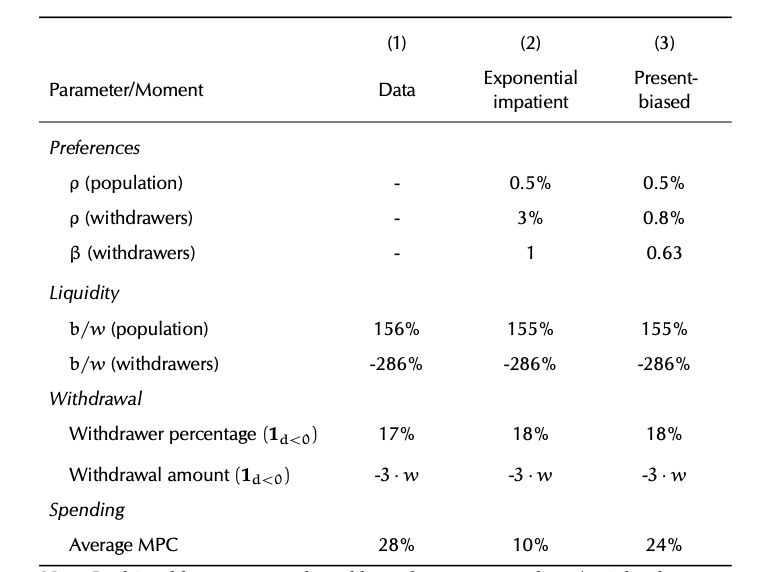
Our second main calibration result: however, only the present-bias version of the model is able to simultaneously match the pre-withdrawal liquidity distribution and the size and speed of the observed spending response. Note the difference in predicted MPCs in the bottom row.
17.12.2024 17:20 — 👍 0 🔁 0 💬 1 📌 0
Our first main calibration result: both heterogeneous impatience and heterogeneous present bias can predict the withdrawal patterns we observe given average parameter values (discount factors and present-bias parameters) that are in the ballpark of those in the recent literature.
17.12.2024 17:20 — 👍 0 🔁 0 💬 1 📌 0We model the policy as a temporary reduction in the (arbitrarily high) cost of withdrawing from the retirement account.
We compare two types of preferences in the model: heterogeneous exponential discounting (impatience) and heterogeneous hyperbolic discounting (present bias).
To do so, we develop a heterogeneous-agent model incorporating retirement, two assets, idiosyncratic income risk, borrowing constraints, and preference heterogeneity, and use it to study the effects of the early superannuation withdrawal program on both withdrawal and spending.
17.12.2024 17:20 — 👍 0 🔁 0 💬 1 📌 0On the face of it, there may be many reasons to observe these withdrawal and spending patterns. For this new version, we overhauled our calibration exercise, in which we seek formally to discern the roles of liquidity constraints and preferences in driving the observed responses.
17.12.2024 17:20 — 👍 0 🔁 0 💬 1 📌 0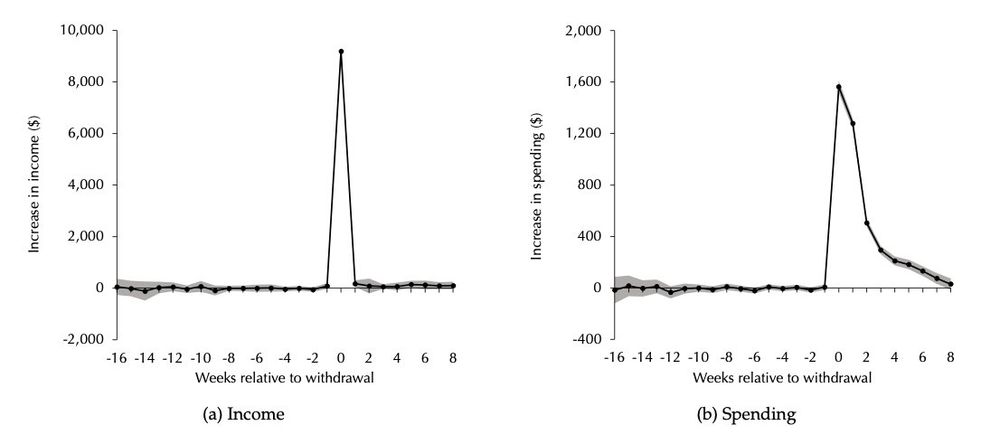
The empirical results are unchanged since the first version from March 2023. The key results are:
1) strong selection into withdrawing retirement savings on the basis of poor financial health; and
2) a very large and sharp spending response, positively correlated with selection.

During the pandemic, Australia for the first time allowed people to withdraw up to $20k from their normally illiquid mandatory private retirement saving accounts. 1 in 6 people withdrew a total of 2% of GDP. We use admin and bank transaction data to study withdrawal and spending.
17.12.2024 17:20 — 👍 0 🔁 0 💬 1 📌 0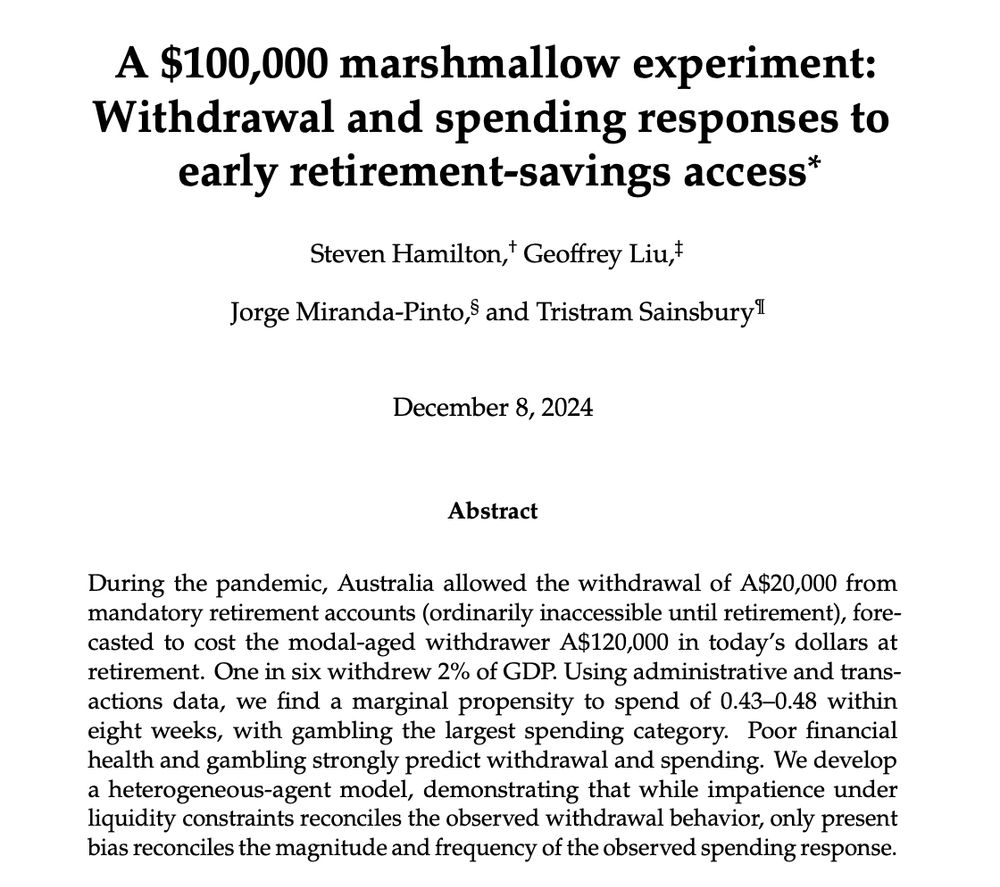
Here's a new version of our paper on Australia's pandemic pension withdrawals, our third major revision. This revision brings a new title, a narrative reframing, and a major overhaul of our calibration exercise. 🧵
static1.squarespace.com/static/59b0b...
More from me on this in tomorrow’s Financial Review.
15.12.2024 04:10 — 👍 9 🔁 1 💬 1 📌 1Rather than the 44% nuclear cost saving claimed by the coalition, the true nuclear cost saving claimed by the modelling is actually just 12%. But because the modelling uses an implausibly low capital cost and high capacity factor for nuclear, even this 12% claim isn't credible.
15.12.2024 04:10 — 👍 8 🔁 1 💬 1 📌 0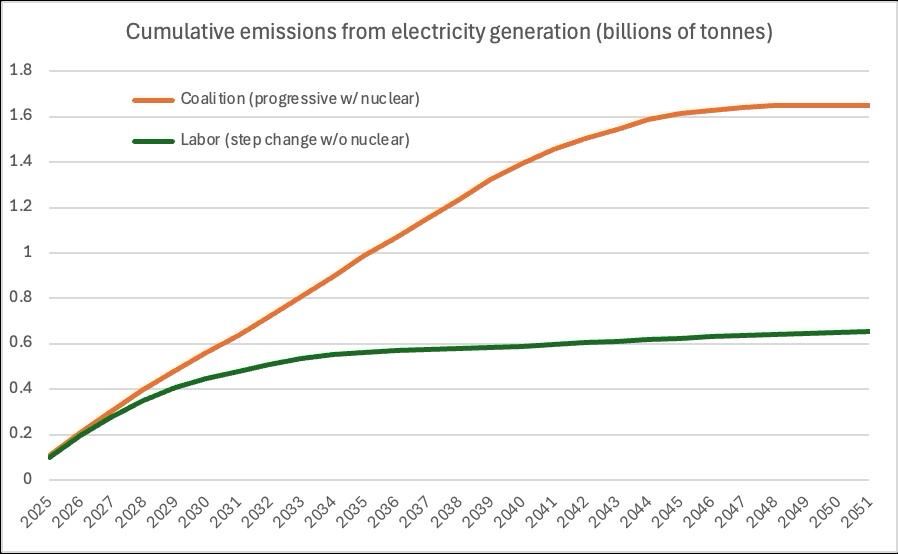
The coalition's nuclear plan released on Friday achieves its claimed cost savings not primarily by nuclear being cheaper than firmed renewables but by replacing firmed renewables with existing coal power. That results in an additional 1 billion tonnes of emissions (worth ~$180b).
15.12.2024 04:10 — 👍 23 🔁 11 💬 1 📌 2Opening a book on Chalmers RBA Board appointments. Taking submissions (this is not a real thing):
Jeff Borland $1.50
Cherelle Murphy $3.50
Stephen Koukoulas $5.20
Angela Jackson $6.00
Craig Emerson $9.00
Nicki Hutley $21.00
Zac Gross $51.00
Richard Holden $51.00
Steve Hamilton $1001.00

See here:
09.12.2024 18:02 — 👍 2 🔁 0 💬 0 📌 0Yes. Government spending as a percentage of GDP has risen from 24.5% of GDP, around its historic average, to more than 27% of GDP in just two years. The public sector is exploding.
09.12.2024 17:57 — 👍 1 🔁 0 💬 1 📌 0Inflation has fallen under elevated interest rates, which have caused the private sector to contract, as I described. That’s the problem.
09.12.2024 17:55 — 👍 0 🔁 0 💬 0 📌 091%!
09.12.2024 15:13 — 👍 0 🔁 0 💬 1 📌 0I agree. I don’t understand how this is inconsistent with anything I wrote.
09.12.2024 14:21 — 👍 1 🔁 0 💬 0 📌 02. No. If you extend the series back the explosion is unique and pronounced. This is literally the fastest non-market employment growth on record and some of the weakest market employment growth on record. Meanwhile, government spending was stable at ~24.5% and has risen to >27% in 3 years.
09.12.2024 13:58 — 👍 1 🔁 0 💬 1 📌 01. Nobody claimed it’s 0% private employment. That’s why it’s labeled “non-market”, not private. Australia has a mixed economy. Those “non-market” jobs are overwhelmingly directly provided by or heavily subsidized by govt. There is no mystery here—government spending has exploded concomitantly.
09.12.2024 13:56 — 👍 0 🔁 0 💬 1 📌 0